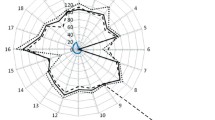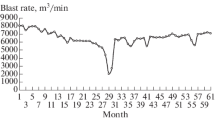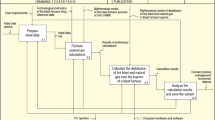Abstract
In the article, one has presented a mathematical description and an algorithm for prediction of tuyere areas’ parameters and control over the distribution of blast parameters around a blast furnace based on the application of patterns of heat transfer between the hot blast and cooling water for tuyere elements. The algorithm has been designed to align the thermal condition of the tuyere areas of a blast furnace along the circumference. It entails the calculation of the following parameters for each tuyere: output and composition of the hearth gas, heat removal from a tuyere, hot blast blowout velocity from a tuyere, kinetic energy of the hot blast, total mechanical energy of the blast flow, length of circulation and oxidation zones, and theoretical combustion temperature. One calculates the mean values of parameters, the area of oxidation zones, and the relative area of tuyere areas. It has been shown that, in case of the non-uniform distribution of the hot blast to tuyeres, to stabilize the thermal state of tuyere areas and to align the gas distribution along the furnace circumference, one is required to adjust the natural gas flow rate to each tuyere to maintain the theoretical combustion temperature at a target level.
Access provided by Autonomous University of Puebla. Download conference paper PDF
Similar content being viewed by others
Keywords
1 Introduction
When operating a blast furnace, the actual distribution of the hot blast to tuyeres is far from uniform: differences in blast flow rate at individual tuyeres, ranging from 5 to 50%, are observed [1,2,3,4,5,6,7,8,9]. Uneven distribution of the hot blast to tuyeres leads to different lengths of tuyere areas. This causes a difference in the speed of material descent in the individual sections of the furnace and concurrently a distorted gas flow along the furnace cross section [7,8,9,10]. In case of uncontrolled distribution of the blast to tuyeres, gas temperature in tuyere areas will vary and maintaining the theoretical combustion temperature within the optimal range will become impossible without the redistribution of natural gas between tuyeres of the furnace.
Several published papers [2,3,4, 7,8,9,10] describe methods and ways of controlling blast flow rate through blast furnace tuyeres. However, they are extremely short-lived and unsustainable due to elevated temperatures and aggressiveness of the hot blast. In recent years, systems for control over the hot blast flow rate to tuyeres, based on the application of patterns of heat exchange between the blast and cooling water of tuyere elements, have been developed [9,10,11,12,13,14].
2 A Mathematical Computational Model and a Calculation Algorithm
In this paper, authors employed the method of determining the blast flow rate to tuyeres, based on numerical simulation of the heat power of the flow passing through a tuyere and the value of heat taking off from this tuyere. Block diagram of the algorithm for prediction of tuyere areas’ parameters and control over blast parameters distribution around the blast furnace is shown in Fig. 1.
In numerical simulation, it is assumed that when the blast passes through the tuyere, part of the heat flow is transferred to the water cooling the tuyere, and to a greater extent, the higher is the heat power of the passed heat. This assumption is reasonable, since the design of all tuyere installed in the furnace is the same, the wall thickness of all tuyeres is the same, the coefficients of heat transfer from blast to tuyere and from tuyere to cooling water are also constant; the heat transfer coefficient of tuyere walls is assumed constant.
To calculate the blast distribution to each tuyere, one determines the mean value of the heat flow of the blast passing through tuyeres based on the average performance indices of a blast furnace as a whole:
where n is the number of tuyeres, pcs.; Q—a blast flow rate, m3/min. CB—a hot blast heat capacity, kJ/(m3·К); tB—a hot blast temperature, °C; CN.G.—a heat capacity of natural gas, kJ/(m3·К); VN.G.—a specific natural gas flow rate, m3/t of molten iron; tN.G.—a natural gas temperature, °C; P—a furnace production rate; t—molten iron/day.
When this heat flow passes through a tuyere, part of it is transferred through the walls of the tuyere to the cooling water and heats the latter. The numerical value of such heating determines the heat removal from a tuyere:
where m is a water flow rate for tuyere cooling, kg/min; CH2O—a heat capacity of cooling water, kJ/(kg·K); ∆t—a temperature difference of water when passing the tuyere, °C.
The average fraction of heat transferred from the heat flow of the blast going through the tuyere to the cooling water will be equal to:
It is assumed that the value of α is constant for all tuyeres and is determined by the averaged performance indices of the blast furnace as a whole. Then the blast flow rate to the individual ith tuyere is determined from the equation:
where \(\left( {m \, \cdot \, C_{H2O} \cdot \, \Delta t} \right)_{i}\) is the value of heat removal from the ith tuyere, kJ/min; \(Q_{{\text{B}}}^{i}\)—a blast flow rate through the ith tuyere, m3/min; \(V_{N.G.}^{i}\)—a set flow rate of natural gas through the ith tuyere, m3/h.
From this equation, with a known value of the α coefficient, one calculates the estimated value of blast flow rate to the ith tuyere:
In the employed calculation algorithm, with known characteristics of the blast at tuyeres (flow rate, temperature, pressure, humidity, oxygen content in the blast, and natural gas flow rate) and tuyere diameter, one calculates blast blowout velocity, value of kinetic energy, and total mechanical energy of the blast flow at each air tuyere. The values of kinetic and total mechanical energy of the blast flow determine the length of the circulation zone, the numerical value of which corresponds to the oxygen content in the gaseous phase of the tuyere area equal to 2% and the length of the oxidation zone of the tuyere area (corresponds to CO2 content in the gaseous phase equal to 2%) [15,16,17,18,19]. Subsequently, one determines the area of the oxidation zone of each tuyere area and the total area of these zones, related to the cross section of the hearth [20]. Based on the blast flow rate and the output of hearth gas at the found values of the heat content of the hearth gas and the known flow rate of natural gas for each tuyere, one calculates the theoretical combustion temperature in the tuyere areas according to the procedure presented in the papers [19,20,21].
With uneven distribution of the blast and supplied natural gas to tuyeres, one has observed significant variations in the theoretical combustion temperature along the circumference of the furnace in the tuyere areas. To eliminate the existing unevenness of tuyere areas’ heating, it is necessary to redistribute the natural gas flow rate to tuyeres, focusing on the established unevenness of blast distribution.
For this purpose, at the first stage, one sets the value of the theoretical combustion temperature in the tuyere areas. At each tuyere at a known blast flow rate, one calculates the natural gas flow rate, which is necessary to stabilize the theoretical combustion temperature at known temperature, moisture, and oxygen content of the hot blast. Further, one calculates the parameters of tuyere areas when the theoretical combustion temperature has been stabilized at a predetermined level.
A complete list of initial data for calculating the distribution of hot blast over blast furnace tuyeres is presented in Tables 1, 2, and 3. It includes the design dimensions of the blast furnace, the technological parameters of blast furnace process, and the parameters of each tuyere.
Table 4 presents some performance indices of the blast furnace process and calculated data pertinent to the parameters of individual tuyere areas at blast furnace No. 2 at PAO MMK (PJSC Magnitogorsk Iron and Steel Works).
The histogram of the measured and required natural gas flow rates for the blast furnace tuyeres is shown in Fig. 2.
The estimated blast distribution to tuyeres is uneven: the maximum value of blast flow rate has been observed at tuyeres No 13 and 14 (152 and 148 m3/min, respectively) and the minimum—at tuyeres No 3 and 6—108 and 102 m3/min, respectively. Calculated value of tuyere areas’ circulation zone length varies from 1.19 m (tuyere No 6) and reaches the maximum of 1.69 m at air tuyere No 13. Values of the theoretical combustion temperature for separate tuyere areas vary from 1958 °C at tuyere No. 6 to 2088 °C at tuyere No. 13. Increase in the natural gas flow rate, required to stabilize the theoretical combustion temperature at a target level of 2050 °C, will contribute to the alignment of gas distribution around the furnace.
3 Conclusion
Therefore, the distribution of hot blast to the blast furnace tuyeres is uneven, and it is determined by the blast furnace operation practice and the design of the air supply ductwork. It has been shown that when the blast is unevenly distributed to the tuyeres, to stabilize the thermal state in the tuyere areas and to align the gas distribution around the furnace, one is required to adjust the natural gas flow rate to each tuyere to maintain the theoretical combustion temperature at a set target level.
References
Bol’shakov VI (2007) Technology of highly efficient energy-saving blast-furnace smelting. Naukova Dumka, Kiev, pp 411
Tovarovskii IG (2009) Blast furnace smelting. Porogi, Dnepropetrovsk, pp 768
Geerdes M, Chaigneau R, Lingiardi O et al (2020) Modern blast furnace ironmaking: an introduction (4th edn), pp 274
Kurunov IF (2015) Modern state of blast-furnace production in China, Japan, South Korea, Western Europe, North and South America. Metallurg 7:12–22
Peacey JG, Davenport WG (1979) The iron blast furnace: theory and practice. Pergamon Press, pp 266
Ertem ME, Gurgen S (2006) Energy balance analysis for Erdemir blast furnace number one. Appl Therm Eng 26:1139–1148
Shirshov MYu, Druzhkov VG, Pavlov AV, Prokhorov IE (2014) Results of evaluation of the uniformity of distribution of the blast over the tuyeres of blast furnaces. In: Theory and technology of metallurgical production, Magnitogorsk State Technical University, Magnitogorsk, vol 2, pp 27–31
Nakajima R, Kishimoto S, Hotta H, Ishii K (1990) New technology of blast-furnace smelting with the use of regulating valves of hot blast in the tuyere devices. NKK Tech Rev 59:1–7
Mozharenko NM, Paranosenkov AA, Negoda VI (2005) Development of the systems of monitoring and regulation of the hot blast flow rate in air tuyeres of the blast furnace. In: Fundamental and applied problems in ferrous metallurgy, Institute of Ferrous Metallurgy, vol 10. Ukrainian NAS, Dnipropetrovs’k, pp 71–78
Mozharenko NM, Kanaev VV, Paranosenkov AA et al (2005) Automated system of monitoring of the blast flow rate in air tuyeres of the blast furnace. In: Fundamental and applied problems of ferrous metallurgy, Institute of Ferrous Metallurgy, vol 11. Ukrainian NAS, Dnipropetrovs’k, pp 34–42
Kanaev VV, Kobeza II, Buzoverya MT, Shuliko ST (1995) Monitoring of the distribution of blast over the air tuyeres of a blast furnace. Metallurg. Gorno-Rudn Promysh 2:69–71
Bugaev KM, Antonov VM, Varshavskii GV et al (1987) Vlijanie raspredelenija dut’ja po furmam na gazovyj potok v domennoj pechi (Influence of the distribution of blast by tuyeres on the gas flow in a blast furnace). Steel 2:17–22
Polinov AA, Pavlov AV, Onorin OP et al (2018) Blast distribution over the air Tuyeres of a blast furnace. Metallurgist 62(5–6):418–424
Andronov VN, Belov YuA (2002) Estimation of the efficiency of distributions of blast and natural gas over the tuyeres. Steel 9:15–17
Lyalyuk VP, Tarakanov AK, Kassim DA, Riznickii IG (2018) Increasing uniformity of blast distribution along BF circumference. Metallurg 2:30–34
Lyalyuk VP, Kassim DA, Tovarovskii IG (2018) Uniformity of blast-furnace parameters over the perimeter. Steel Translation 48(3):179–184
Lyalyuk VP, Tovarovskii IG (2003) Vybor rezhimov domennoj plavki na kombinirovannom dut’e s ocenkoj parametrov furmennoj zony (Selection of modes of blast-furnace smelting on combined blast with estimation of the parameters of tuyere zones). Chernye Metally 11:13–16
Lyalyuk VP (2020) Analysis of the blast furnace operations with a volume of 5000 m3 on tuyeres of different diameters from the positions of full mechanical energies of flows of combined blow and hearth gas. Ferrous Metallurgy. Bull Sci Tech Econ Inf 76(7):691–699
Onorin OP, Spirin NA, Terent’ev VL et al (2005) Komp'juternye metody modelirovanija domennogo processa (Computer methods of simulation of the blast-furnace process). USTU-UPI, Ekaterinburg, pp 301
Spirin NA, Lavrov VV, Rybolovlev VYu et al (2011) Model’nye sistemy podderzhki prinjatija reshenij v ASU TP domennoj plavki metallurgii (Model systems for the support of decision making in automatic systems of control over the technological process of blast-furnace smelting in metallurgy). UrFU, Ekaterinburg, pp 462
Spirin NA, Lavrov VV, Rybolovlev VYu et al (2014) Matematicheskoe modelirovanie metallurgicheskih processov v ASU TP (Mathematical modeling of metallurgical processes in automated process control systems). UrFU, Ekaterinburg, pp 558
Author information
Authors and Affiliations
Corresponding author
Editor information
Editors and Affiliations
Rights and permissions
Copyright information
© 2022 The Author(s), under exclusive license to Springer Nature Switzerland AG
About this paper
Cite this paper
Gurin, I.A., Spirin, N.A., Lavrov, V.V. (2022). Predictive Algorithm for Tuyere Areas’ Parameters and Control Over the Distribution of Blast Parameters Around a Blast Furnace. In: Radionov, A.A., Gasiyarov, V.R. (eds) Proceedings of the 7th International Conference on Industrial Engineering (ICIE 2021). ICIE 2021. Lecture Notes in Mechanical Engineering. Springer, Cham. https://doi.org/10.1007/978-3-030-85233-7_89
Download citation
DOI: https://doi.org/10.1007/978-3-030-85233-7_89
Published:
Publisher Name: Springer, Cham
Print ISBN: 978-3-030-85232-0
Online ISBN: 978-3-030-85233-7
eBook Packages: EngineeringEngineering (R0)






